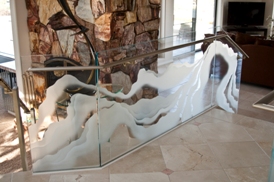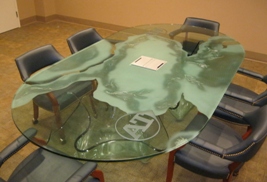The infinite possibilities are crystal clear.
Every time I gaze up at the multi-hued light pouring through stained glass windows in a Renaissance-era cathedral, I'm captivated. Art glass has always been a fascination, so maybe it's sublime fate that nanotechnology is part of its beauty.
It's true -- nano-gold was used to create red glass going back to ancient Egypt, and in the Middle Ages gold and other nanoparticles became elements in the new art of stained glass. So nanotechnology is surely part of the secret of the deep purples, heavenly blues and warm golds that have tinted the sun's rays on centuries of pilgrims.

Probably the most familiar are glass nanocoatings to repel water. What started as rain-repellant car windows has found a new use in our high-tech society. Today, there are moisture-resistant nano-coatings on your smart phone and iPad -- so you can chat in a rainstorm or weather a coffee spill.
I like the self-cleaning or anti-soiling coatings, too. Solar panels lose efficiency when they're dirty, so you could say nanotechnology turns glass “green” by keeping sun-power more powerful. It also boosts sustainability because the panels need to be cleaned less often -- less water use, fewer detergents. The same applies to easy-clean or self-cleaning architectural windows, ceramic tile walls even glass dinnerware. And, certainly, sustainability is something to admire.
Still, I take special delight that art glass makers are embracing the advances of nanotechnology, coming full circle with their ancient past. The advance? Nanocoatings are now helping protect and beautify sand-blasted glass. In architecture. In art. In furniture. This story came to me from Fox Fire Glass, a Michigan glass studio. They make custom sand-blasted art glass -- from residential balcony railings to conference tables.
A sandblasted surface needs to be protected so microscopic pieces won't chip off the peeks of the roughed surface and so dirt and oils won't be trapped in the valleys. While glass sandblasting is a very old art, it seems the available protective coatings did more harm than good. They were known to “dampen” the white-toned sandblasted area, obscuring the contrast that makes a design visible.”
Maybe nanotechnologists were thinking of the grand old stained glass when they developed a nano-coating that retains the contrast of sandblasted glass, as well as protecting it. You can see the artisan's (and nanotechnologist's!) work shining through in the images of art glass I've included here.

Now think small. Etched crystal has always required a “handle with care” label, but maybe nanotech can make it an everyday delight. Glass furniture -- from tables to front doors, wet bars to chandeliers -- could be etched in an ultra-thin layer of subtle artistry.
And maybe it's time to revisit the artifacts akin to those ancient stained glass windows. Could nanotechnology provide precious relics with an invisible barrier against time's ravages? What about protecting the splendor of glass antiques, like Tiffany lampshades or 18th century Venetian glass sculpture?
Out of the lab and into the light -- that's the power of nanotechnology for glass. That's what I call a beautiful idea.
Scott E. Rickert is chief executive of Nanofilm, Ltd., located in Valley View, Ohio.
Source: Industry Week
